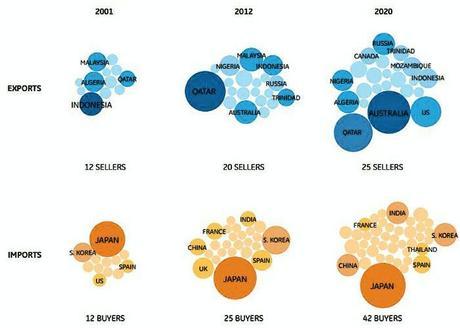 Natural gas flares from a flare-head at the Orvis State well on the Evanson family farm in McKenzie County, North Dakota. (Credit: Flickr @ Tim Evanson http://www.flickr.com/photos/23165290@N00/)
Natural gas flares from a flare-head at the Orvis State well on the Evanson family farm in McKenzie County, North Dakota. (Credit: Flickr @ Tim Evanson http://www.flickr.com/photos/23165290@N00/)
A new GE study titled “The Age of Gas and the Power of Networks” says that natural gas is positioned to rival coal consumption as well as take share from oil on the global stage. The authors of the study, Peter C. Evans and Michael F. Farina, write that gas will also increasingly complement wind and other renewable energy sources in power generation.
As an example of the latter, a new system developed at the U.S. Department of Energy’s Pacific Northwest National Laboratory will allow natural gas plants to save up to 20% of the fuel by injecting solar energy into natural gas.
Evans and Farina say that utilities, global businesses, homes and also trains, trucks, CNG (compressed natural gas) powered buses and other means of transportation have already embraced natural gas. The analysts expect that gas consumption will grow by more than a third from its current level by 2025. They estimate that international trade in liquefied natural gas (LNG) will increase by 70 percent in this decade alone. According to the EIA estimates, natural gas will make up 27 percent of the nation’s electricity by 2020.
The latest flexible combined cycle power plants are reaching thermal efficiencies in excess of 61 percent. That means almost two-thirds of the energy in the natural gas is converted into electricity. “The future of gas is not going to be the same as the past,” Evans and Farina write.

Buyers and sellers on the global LNG market. (Credit: GE Global Strategy and Analytics, 2013). Click to enlarge.
In the Middle East, the share of natural gas in power generation already stands at 60 percent. (It is 28 percent in the U.S. and 20 percent in Europe, although natural gas consumption in Europe has declined since 2011.)
Land-based gas pipelines transport 89 percent of the gas consumed today. They authors say that gas network growth, innovation and new supply options like shale gas are helping create greater gas network density and resilience, and improve economics. “Denser networks contribute to making energy systems more robust and therefore more resilient to disruption and less likely to exhibit extreme price volatility,” they say.
Evans and Farina write that “gas networks, which are often underground, in contrast to road and power grids, can often provide stable service during severe weather events. In this way, gas can contribute broadly to economic resiliency by providing diversification, redundancy, and backup systems.”
The advantages of such distributed power came to light last year during Hurricane Sandy. While large parts of the Northeast were in the dark, a gas turbine located at Princeton University kept the campus lit and warm.
The authors write that innovations like floating LNG technologies and small gas gathering, conversion and transportation systems will also have “dramatic impact” on gas network growth. “The new technologies that help integrate and transform small-scale LNG and CNG systems into ‘virtual pipelines’ will be important to the rapid development of new gas markets like the transportation sector,” they write.
They also believe that the Industrial Internet, which links data from machine sensors to people and software, will bring new tools for monitoring, control and analytics of pipelines, generators and other technology.
“One defining characteristic of networks is that they become more valuable with size as more entities join the network,” Evans and Farina write. “These characteristics facilitate the development of adjacent networks, uncovering hidden opportunities to create value as new links are established.”

